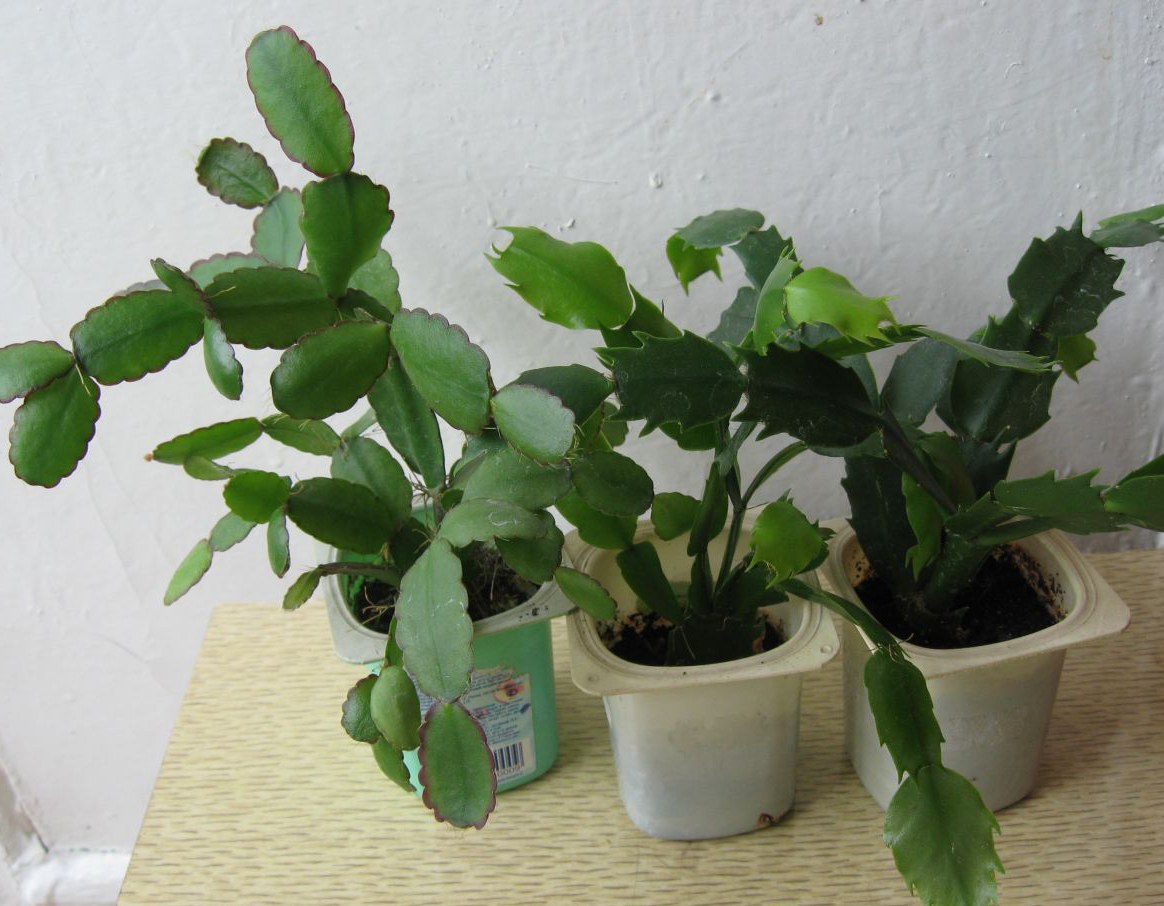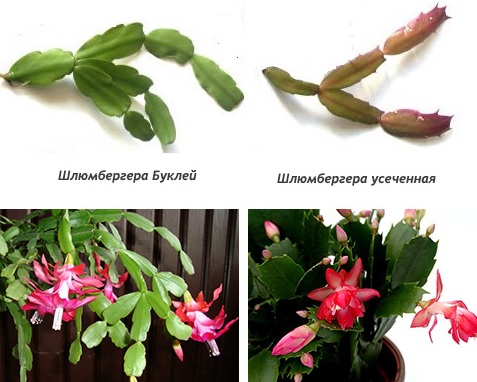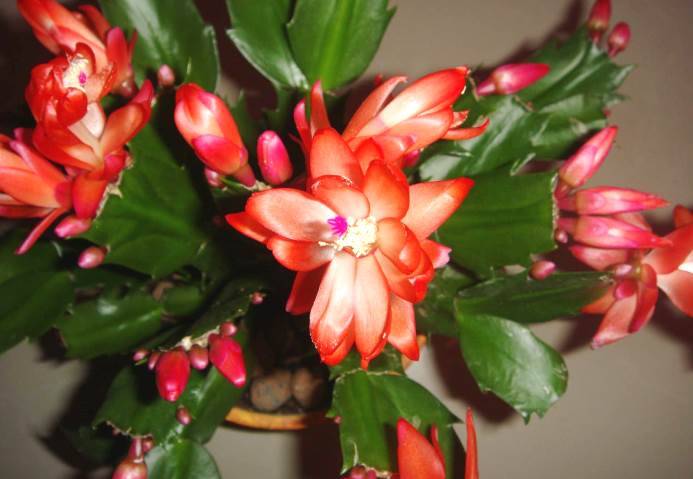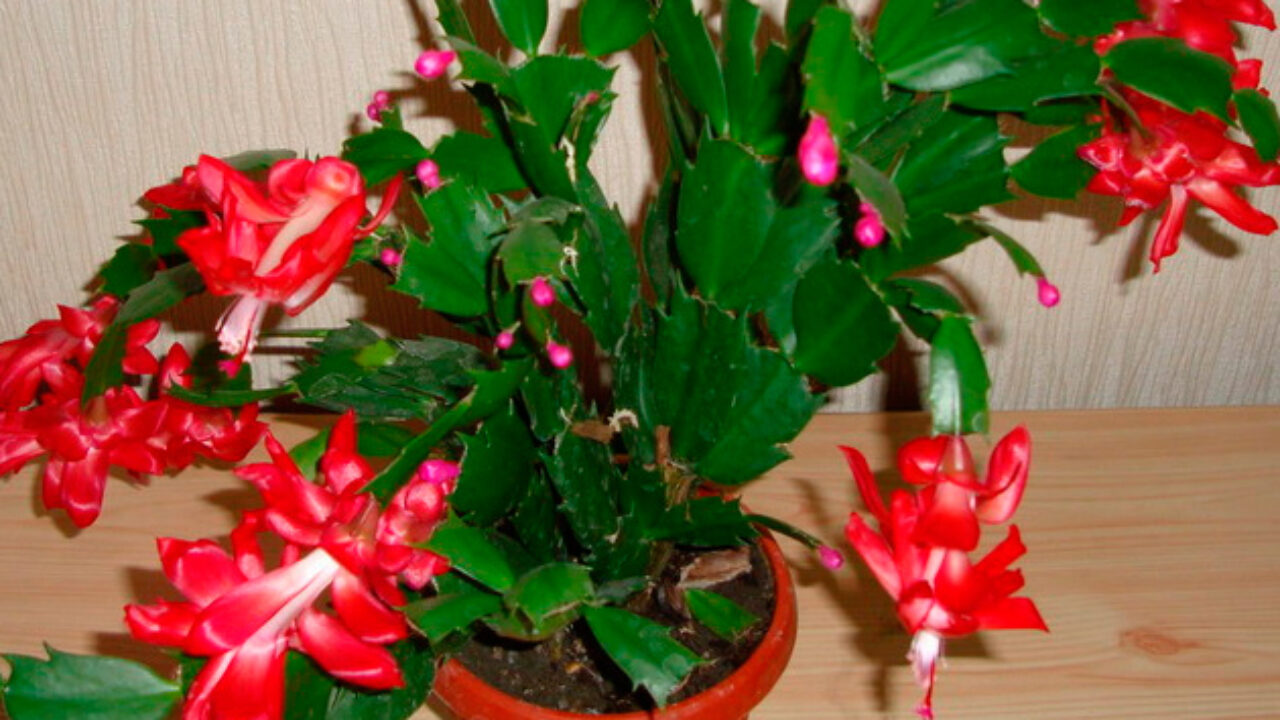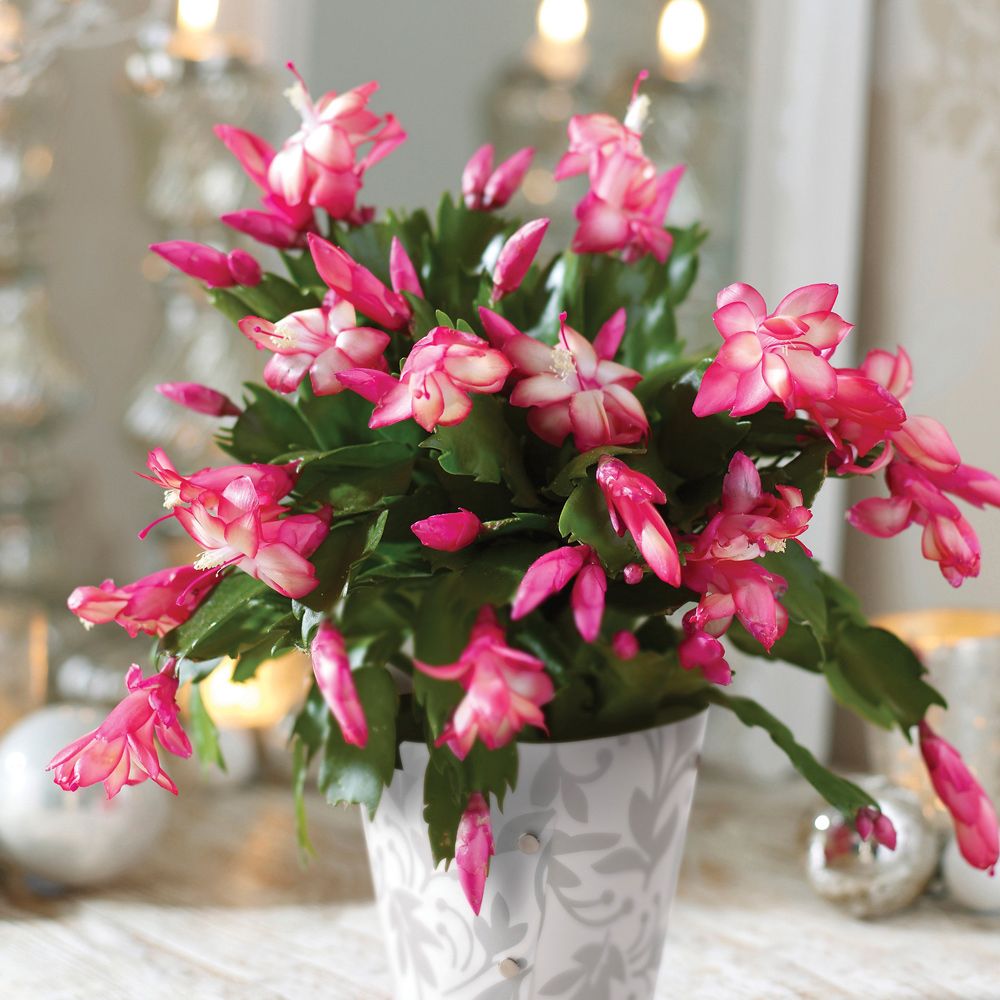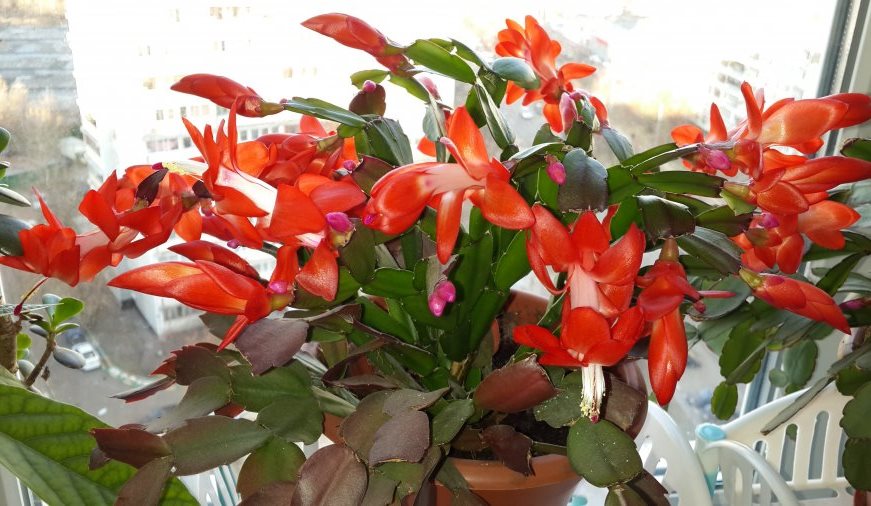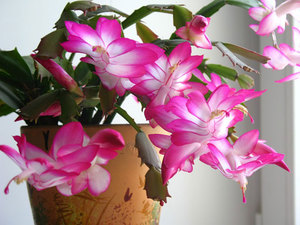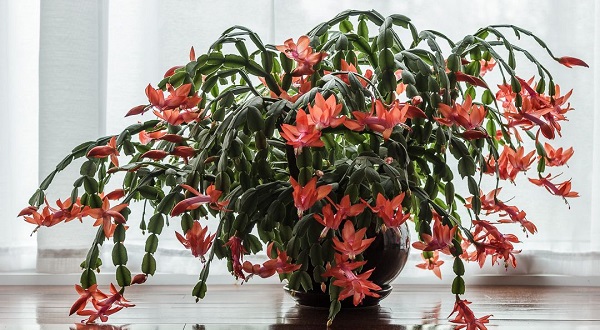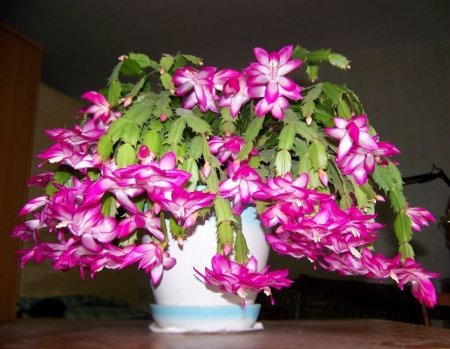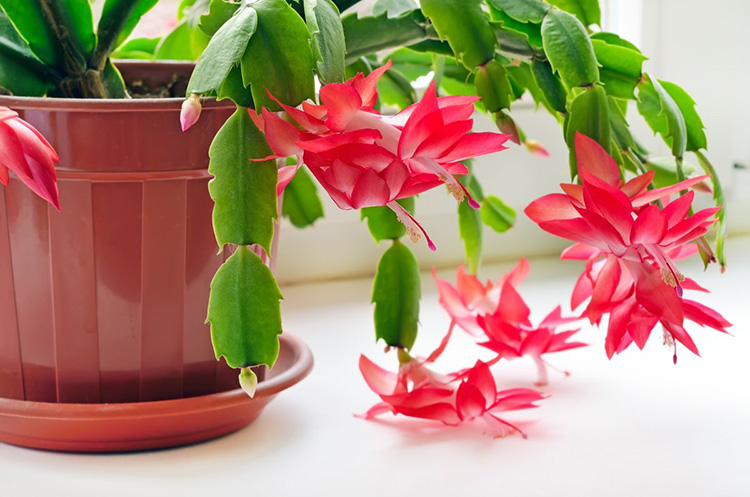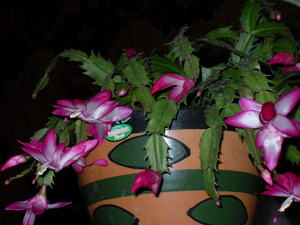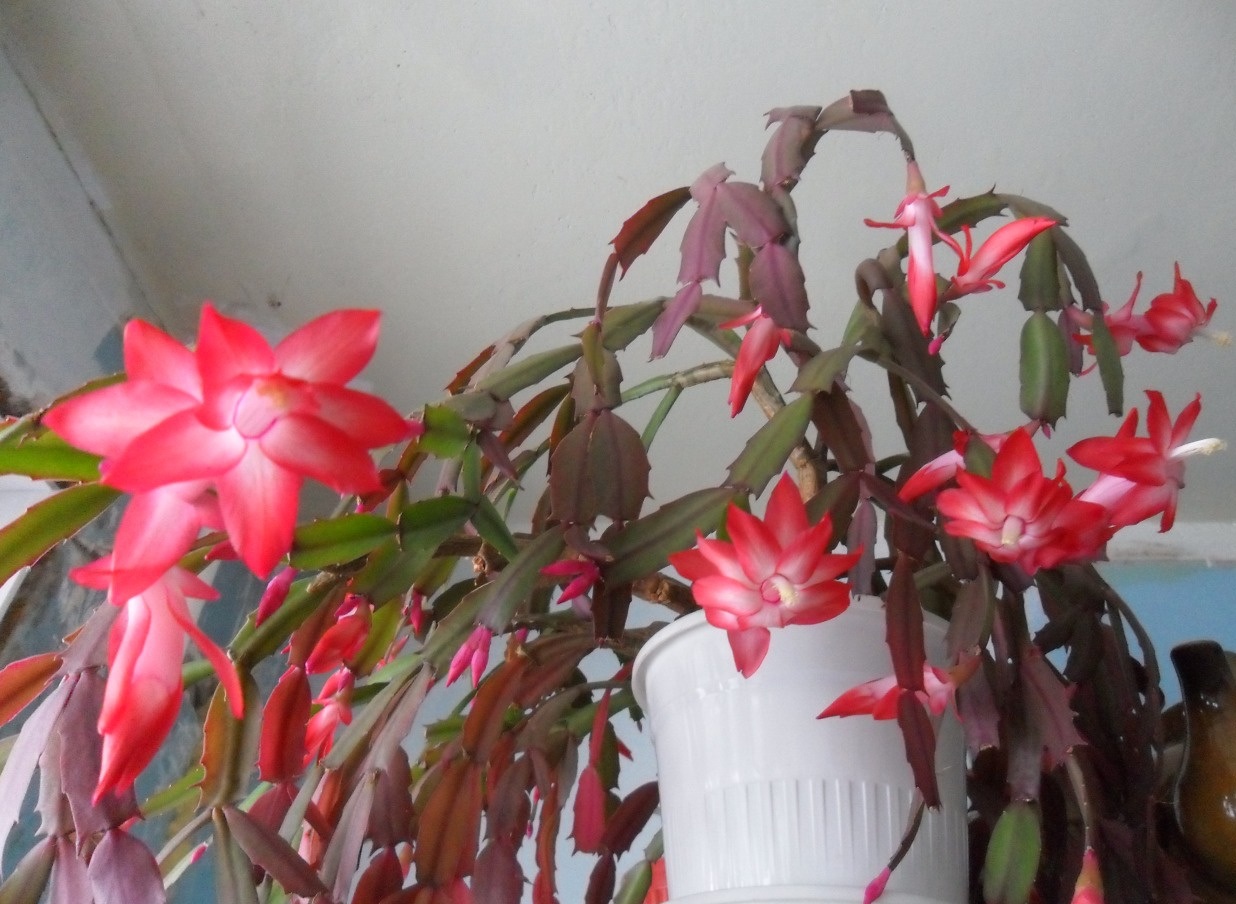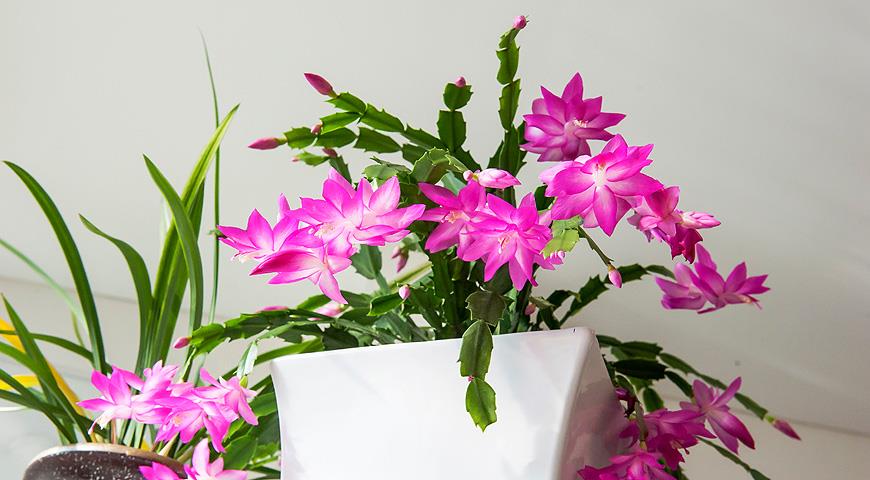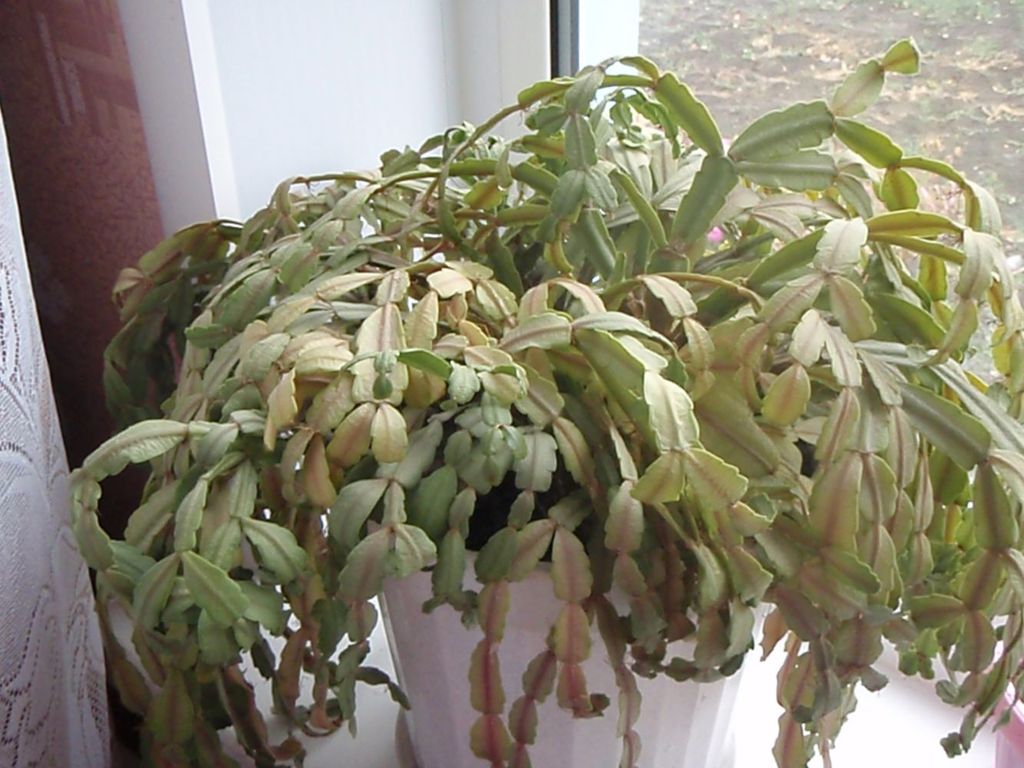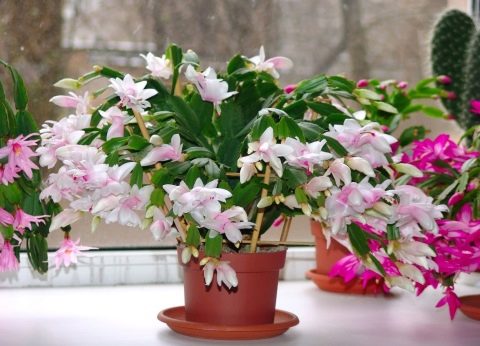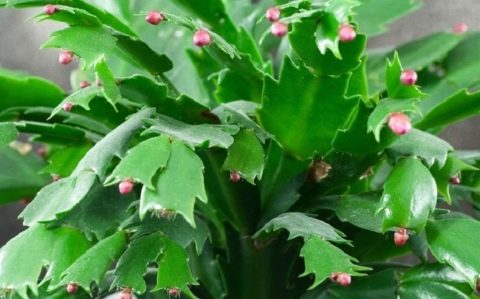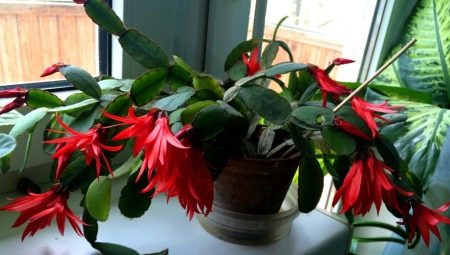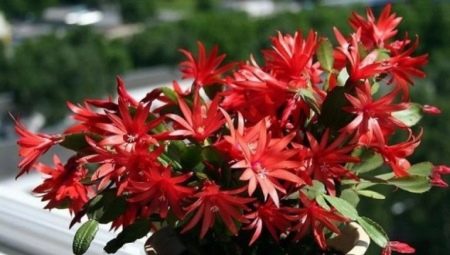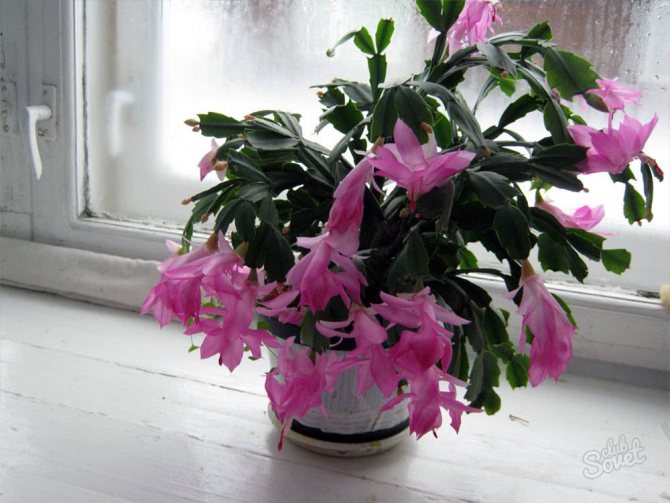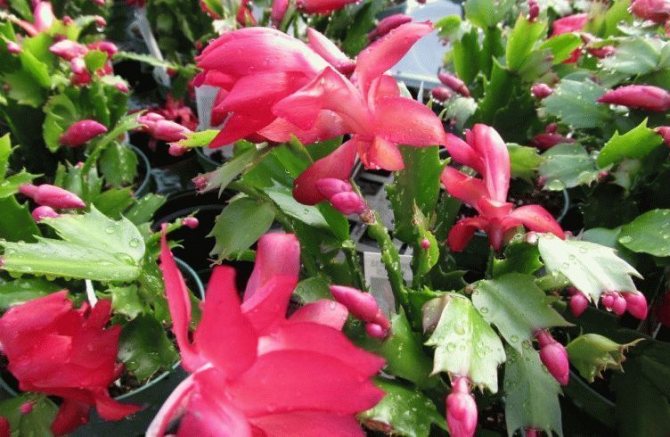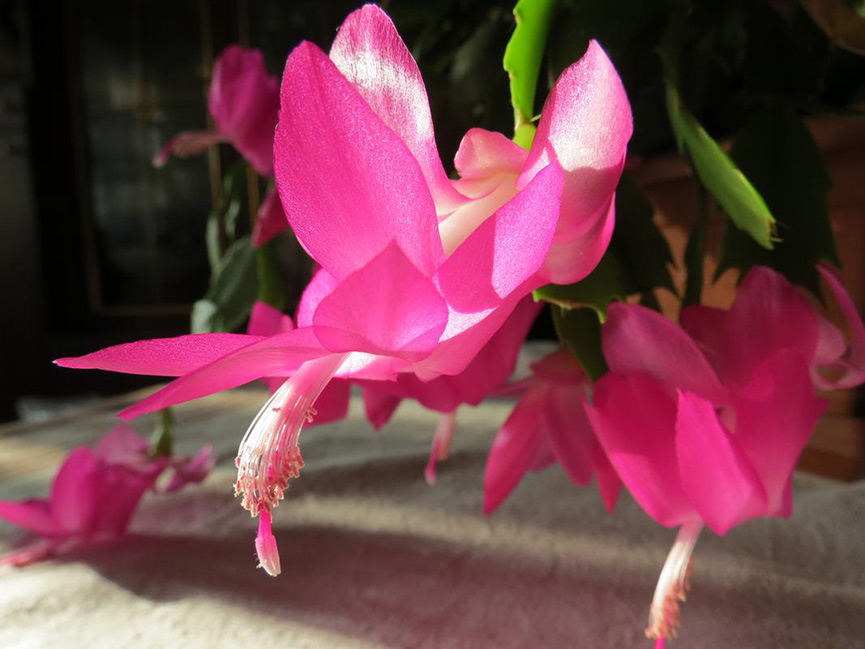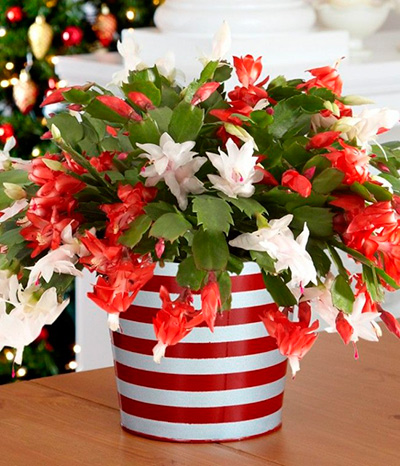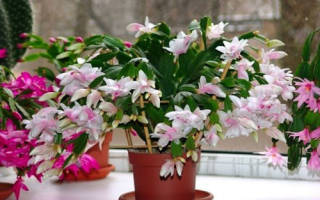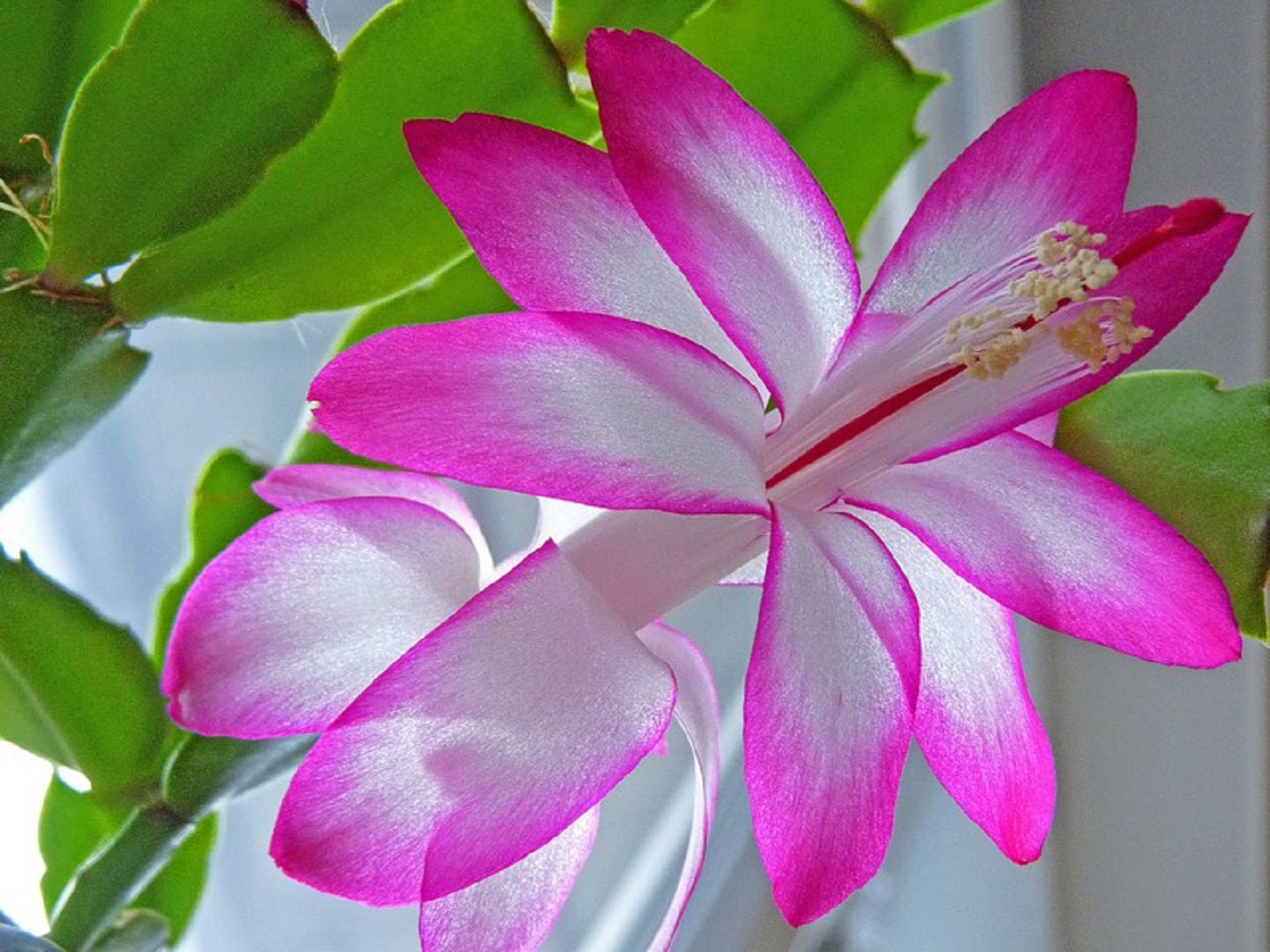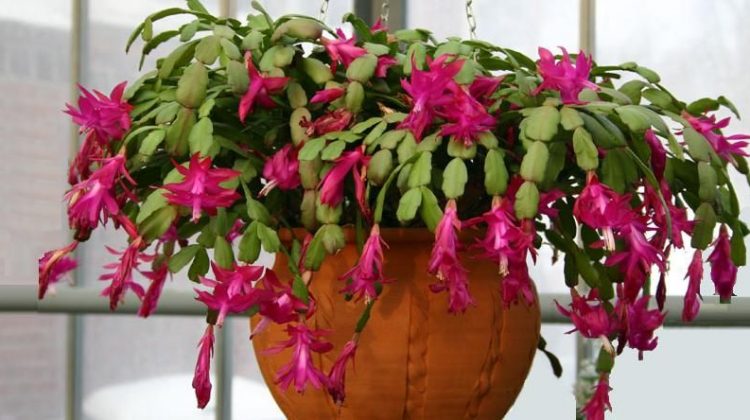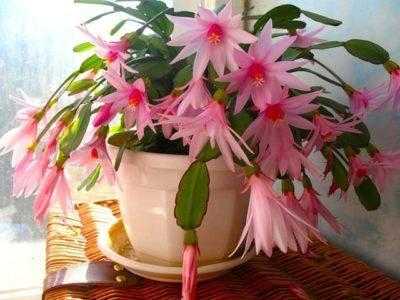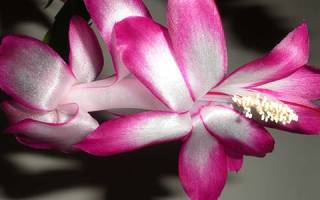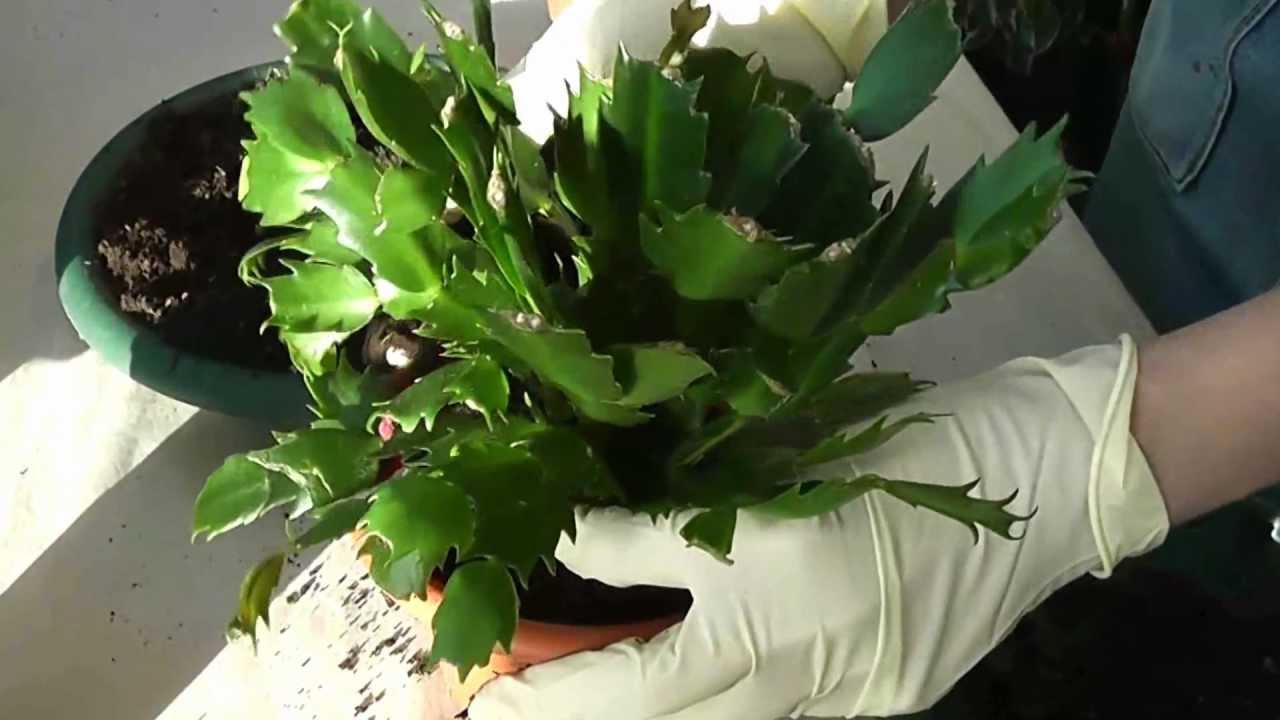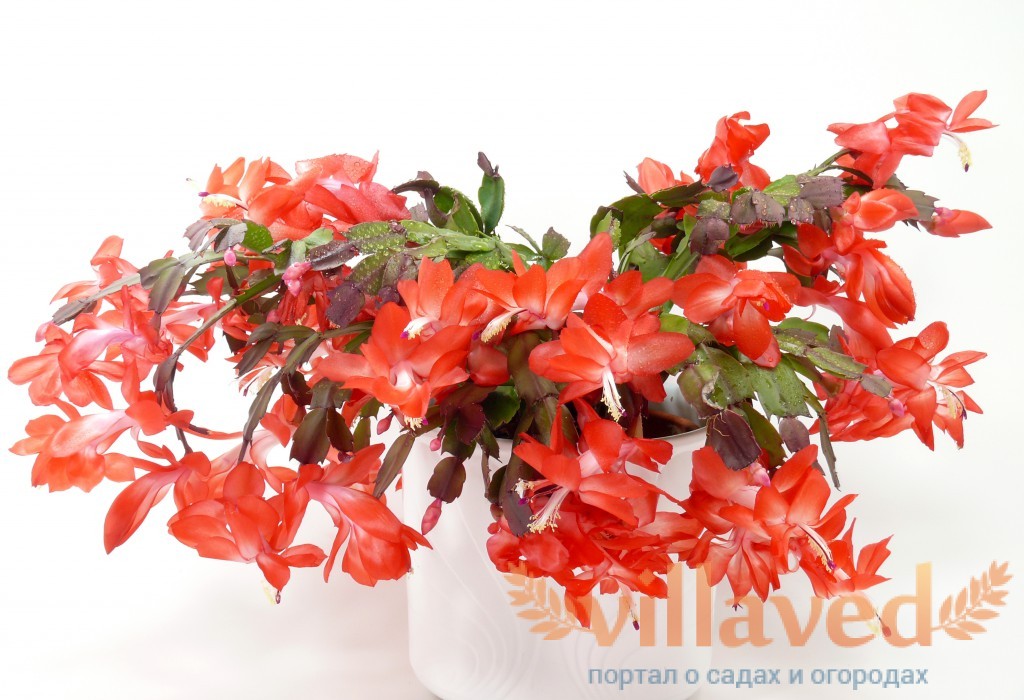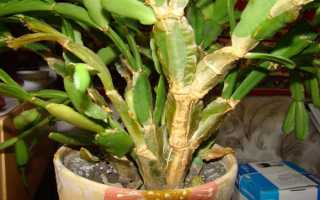Possible growing problems
When leaving in compliance with all the rules, the zygocactus grows well and blooms profusely. However, problems during cultivation can arise, so it is recommended to study the main ones.
Diseases and pests of the Decembrist
The plant can be precipitated by some insects and fungal diseases. Therefore, the leaves of the plant should be periodically inspected.
- If whitish lumps, like cotton wool, appear between the shoots, it means that the Decembrist is infected with a mealybug. Getting rid of a pest is quite difficult. We need urgent treatment of the plant with special preparations that are sold in flower shops.
- The leaves covered with a rusty bloom and an almost invisible cobweb indicate that the zygocactus is infected with a spider mite. They are very small and almost invisible insects of reddish, yellow or brown color. They appear when there is insufficient air humidity. You can get rid of them with the help of the drug "Neoron", "Fitoverm", "Actellik".
- Of the fungal diseases, the Decembrist is most often affected by phytophthora, phytum, fusiriosis. First of all, the root collar of the flower suffers, as a result of which it begins to wither in moist soil, becomes gray and pale, and loses its segments. In this case, the plant must be treated with Vitaros, Topaz and Maxim fungicides. In addition, you need to ensure that the soil does not become waterlogged. It should dry well between waterings.
Why doesn't the Decembrist bloom?
Most often, the reason lies in non-compliance with the growing conditions:
- Insufficient watering.
- Insufficient lighting.
- The pot is too small for the plant and a transplant is required.
- Insufficiently nutritious soil.
For to plant bloomed, it must be properly prepared for flowering. For this, in the fall, he is provided with a dormant period, removing the zygocactus in a cool room. At this time, it practically does not need to be watered and does not need to be fed at all. To make the zygocactus bloom, at the end of November it is moved to a well-lit place and watered. The plant will "wake up" and begin to pick up buds.
To achieve abundant flowering of the Decembrist, it is necessary to properly care for it:
In winter, it is recommended to illuminate the plant with an additional source of illumination.
During the flowering period, the pot must not be moved and rotated, as well as cooking. propagation cuttings.
It is strictly forbidden to expose the plant to temperature extremes during flowering.
If there is cool air in the room, the flowering will last longer.
The bush will bloom profusely in a narrow pot.
A more active flowering is facilitated by a temperature regime not higher than + 16C.
After a dormant period, watering and feeding is resumed very carefully. Otherwise, the plant can get a lot of stress and shed its buds .. If you brought a blooming Decembrist home, and its flowers began to fall off, you should not panic
The plant simply adapts to new growing conditions
If you brought a blooming Decembrist home, and its flowers began to fall off, you should not panic. The plant simply adapts to new growing conditions.
Why does zygocactus wither?
As mentioned above, the plant withers if it suffers from fungal diseases. But there may be another reason - this is rotting of the roots.
If the trunk of the Decembrist began to sway, and the flower itself lost its stability, then it is possible that its roots have died. This can happen as a result of watering with cold water, hypothermia of the plant, or, conversely, from overheating of the flowerpot in the sun. Too much fertilizer can burn the roots.
If such a problem is found, the flower needs to be urgently transplanted into another soil. When transplanting, the roots are examined, the affected ones are removed. Then the root system of the plant is sprinkled with a little crushed coal and dried. After that, the zygocactus is planted in a fresh earthen mixture and watered only as needed.
Why do leaves fall?
Decembrist leaves can fall off, seemingly, for no reason. However, nothing happens so easy, so you should find out the reason:
- If the plant is infected with pests, then it is treated with special preparations.
- If the leaves of the plant are clean, and there are no insects on them, then perhaps the reason is a lack of nutrients. In this case, the Decembrist is watered or sprayed with fertilizers for epiphytic cacti.
- The reasons for the falling off of the end segments can be: a draft, sudden temperature changes, too dry air, or a transplant made at the wrong time.
Fight against pest enemies of the Decembrist flower
Proper care of the Decembrist will help prevent the appearance or overcome pests.
Spider mite
The pest belongs to the class of arachnids, its small rounded body is covered with sparse bristles and has a red or yellow color.
It settles on the underside of plant leaves, light dots on the surface of the leaf indicate its appearance. If you are wondering why the leaves of the Decembrist fall, it is often the spider mite that causes this process. He soon moves to the top side. You can fight them with sulfur and phosphorus chemicals. Spraying with the preparations "Vertimek", "Fitoverm" and "Aktofit" are effective. The tick does not develop resistance to them.
Mealybug
A sucking insect with an oval pink body, covered with a white coating, with transverse stripes on the back.
Mealybug length from 3 to 7 mm. The pest produces white sticky mucus and seems to sprinkle the Decembrist with flour. The Decembrist buds suffer greatly from the mealybug, they wither and fall off.
For the prevention of the worm, the plant should be regularly watered and dried leaves should be removed. If the infection has already occurred, insecticides "Aktara", "Confidor", or folk remedies: horsetail tincture, oil spraying agent will help.
Shield
Although the size of the scabbard does not exceed 5 mm, it can suck out all the juices from the Decembrist. The Decembrist leaves turn yellow and dry out, the plant may even die.
You can get rid of the insect with the help of mechanical cleaning: carry out the treatment with cotton swabs dipped in a solution of "Karbofos" or "Tanrek". Also, high air humidity can provoke the reproduction of scale insects, while bright sunlight slows down their development.
Why does the Decembrist not bloom
Question: My Schlumberger has been growing for several years, I try to take care of it correctly, but why does the Decembrist not bloom?
ITALIA: In one of the books about cacti, I read a piece of advice that I have been using for more than one year. Schlumberger (Decembrist) is a short day plant. The setting of flower buds in them depends on both the length of daylight hours and the temperature. If kept too warm in winter (above 23 ° C), there is strong vegetative growth and a complete absence of flower buds. The lower temperature (17-20 ° C) contributes to the formation of flower buds, but only on condition of a short day. At an even lower temperature (10-15 ° C), flower buds form regardless of the length of daylight hours. Content below 10 ° C prevents bud formation. In this case, night temperatures play a major role. So, above 23 ° C - Schlumberger will not bloom. 17-20 ° C - Schlumberger will bloom if the day is short 10-15 ° C - will bloom regardless of the length of the day. Below 10 ° C, Schlumberger will not bloom.
Kroky: To stimulate the future abundant flowering, it is advised to pinch off the plates - the segments at the ends of the shoots that have already faded.
Influence of seasonality on a plant
The fact that the Decembrist was born in distant Brazil left its mark. In the countries of the Eurasian continent, its seasonality looks completely different and unusual for us. Depending on the time of year, you will need to take care of the Decembrist in different ways.
Compliance with these differences is important so that the Decembrist has time to restore and accumulate strength for the new flowering season.
The period of flowering and the most peak activity falls on the time when the calendar is late autumn and winter. In this cold time, the Decembrist requires constant spraying of the buds. This will provide him with the necessary moisture. When the plant blooms, you do not need to stop spraying.
It is important to monitor the moisture content of the soil and avoid dryness. You will also need absolute rest for the pot and no feeding.
By February, the plant sheds flowers and stops blooming. If the plant does not get rid of the dried flowers on its own, you can help it: carefully tear off the last petals and remove the remnants of the inflorescences. Until April, the flower should be moved to a cooler place and watered once a week.
In April, you need to make the first top dressing - an exhausted flower needs to restore the spent energy. Until June, once a month, fertilizer must be applied to the soil. Required at this stage serving is half the size recommended by the manufacturer. The Decembrist needs to provide partial shade. It is necessary to continue spraying it, from time to time you can wash the leaves with settled warm water.
After feeding, the plant is ready for transplanting or reproduction. Such actions should be carried out at the end of April or in May.
In June, the plant must be moved to fresh air. You can take it outside, or you can put it on the balcony. The main thing is that the plant should not be under the scorching sun. It would be better to place it in a shade or a place where only scattered, indirect rays can reach it. You also need to protect the flower from rain.
During this period, the rhythm of watering changes - you need to water only when the soil begins to dry out. Feeding is also becoming more frequent - now the plant needs to be fed 2 times a month, each time giving a full portion of fertilizers. In such conditions, the Decembrist will live until September, when he has rest period begins... This month, the flower needs to be moved back to the room where it will live before flowering.
Until November, indoor temperature should not exceed 14 ° C and cannot go below 10 ° C. Top dressing should be stopped, and watering should be reduced even more. At this time, the frequency of watering can be up to 1 time in 2 weeks. Flowering begins in November. Therefore, until December, gradually raise the temperature to 15 ° C and resume more frequent watering. The main thing is not to do this abruptly, so as not to injure the flower.
How to make the Decembrist bloom
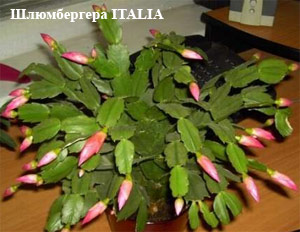
Question: Can you tell me how to make the Decembrist bloom. Mine is already two years old, but he only grows leaves. It hangs in my flowerpot on the east window - only in the leaves rushing. The window is not far from him. And my mother also hangs it, but every winter it blooms, although there is not a cool place at all.
Kleo: To stimulate flowering, the Decembrist needs a cool place, then he picks up the buds. For flowering, you need to stop watering for a while at the end of summer and put the plant in a cool room with a temperature of 15 ° C. And these plants grow well and bloom in partial shade.
Veta: I think mine is blooming, because, firstly, it was on the windowsill, closer to the light - after all, the 16th floor; secondly, it was cold in the apartment, in the kitchen where he was, it was about 13-14 ° C all winter. He spent the summer on my loggia, stood so that he did not get a lot of sun - so, in the morning, a little, but it was still light, regularly fed along with all the other fertilizers "Power of Life". Now it has become cooler on the loggia, I moved it to a brighter place. So he picks up more buds.
Melnikov Vladimir:
- First, they should be planted in dishes as small as possible (depending on their volume). It is necessary to transplant into dishes such that the old bowl freely fits into the new one (that is, about 1-2 cm more per year). The abundance of flowering and growth itself depend on the frequency of transplantation. All of them have a very poorly developed root system and does not require a large amount of soil. If you give more volume than they need, it is the roots that begin to develop, to the detriment of everything else. Do not forget that these are epiphytic plants after all. And they grow like orchids.
- Second: they are all winter flowering plants. And in order for them to bloom profusely, you need to give rest (15 degrees, with watering 1 time somewhere in 1.5-2 weeks) from early October to mid-late November (depends on our unpredictable autumns, i.e. keep the temperature, if it is higher, then watering is necessary!)
- And third: for flowering, you need the brightest place in your apartment, air humidity (I already said that such plants are not suitable for the kitchen) and, starting in autumn, do not twist, do not carry (i.e. rearrange) this plant. Further, if you have a stalk from an adult, flowering plant, then if these conditions are met, it will bloom for the second year maximum.
Why there is no flowering for several years, how to make the zygocactus bloom?
There are no exceptions when a Christmas tree has stopped blooming and has not been happy with flowering for several years, stops its growth, and in order to understand what to do, you need to understand the reasons why Schlumberger does not bloom:
- lack of proper lighting (little light);
- unsuitable pot size, which should be medium in order to avoid excessive root growth;
- unsuitable soil;
- lack of watering and lack of feeding;
- the plant has not been transplanted for several years.
To bring the Christmas tree back to life and make it bloom, you need to remove the plant out of the pot and carefully examine the root system for damaged or dry areas.
If any are found, then it is necessary to eliminate them, and wipe the sections with an antiseptic or sulfur. Next, you need to move the Schlumberger into a special soil for cacti, if necessary, you can change the pot to a more suitable one.
Important! After transplanting, watering the plant should be restored, fertilized with nitrogen fertilizing and put the pot in a bright place, but avoiding open sunlight. After the performed "operation", the Christmas tree will definitely start to grow .. Unfortunately, Schlumberger often actively develops, but does not bloom for several years.
Unfortunately, Schlumberger often develops actively, but does not bloom for several years.
Seasoned florists recommend arranging "drying" for the Christmas tree:
- It is taken out to a cool place and watering is stopped.
- After 2-3 weeks, the Decembrist is returned to the heat and begins to water and fertilize as usual. After such a stressful situation, in most cases, buds appear on the plant, and after 2 months the flowering period begins.
Here's how to adjust the seasonal cycle and make the Christmas tree bloom in the winter.
Reasons for dropping buds
The moment of bud formation on the Decembrist is the most exciting. The flower is about to sing its swan song. How to take care of him during this crucial period of cultivation?
Pot immobility
The florist needs to follow the main rule: the pot must stand on one and the same same location. Therefore, the container must not be rotated, for example, so that the buds and blossoming flowers can be seen. It is forbidden to move the cactus to another place.

At work, I also have a Decembrist growing up. There it is more inclined to bloom than a house flower. Only one day there was a nuisance - a bud fell. At first, I thought of my colleagues, and then I remembered dusting and turning the pot so that the plant looked better on the windowsill.
Watering
It so happened that I forgot to water. Because of this, the plant depleted its reserve of strength. Despite the fact that this succulent is resistant to moisture loss in the soil, the test turned out to be overwhelming. Therefore, the flowers fell off.
Lack of diseases and pests
Zygocactus, like any other plant, can get sick. With frequent watering, the presence of dampness can intensify the growth of harmful microorganisms. Hence fusarium, late blight, phytium.
Attack spider mites and mealybugs Is a common problem faced by Schlumberger owners. I am also familiar with this misfortune. Gray spots appeared on the leaves, which were removed with a finger or washed off.
Shower and soapy water treatment did not give any result. Only insecticides helped in pest control.
Natural conditions helped to cure the Decembrist.
Warmth and no drafts
If you open the window in winter and leave the plant for a long time, you will not be able to temper the Decembrist, he will drop the inflorescences. The flower will not continue the genus in extreme conditions.
How to make a plant bloom
Besides dropping buds, a common problem is not blooming. In order for the plant to release buds, you need to create certain conditions and take care of the scheme.
- At the end of September, I put the pot in a cool place and reduce watering.
- In a month, I provide the zygocactus with warmth and abundant watering.
- I apply a complex mineral fertilizer.
How to feed the Decembrist
Question: How to feed the Decembrist?
Buttercup: I fertilize with Fertika-Lux (previously called Kemira) the dose is 1/3 less than for all flowers, everything is fine.
ITALIA: In the spring and in the first half of summer I feed with fertilizer for cacti, and during second half of summer and in early autumn (i.e. before the dormant period) I switch to fertilizer for flowering plants.
Natali: better fertilizer for cacti, which contains a set of trace elements (boron, manganese, copper, molybdenum, etc.), a little nitrogen and more phosphorus and potassium. But some fertilizers for cacti contain calcium, and the Decembrist does not really need it (it does not have thorns). Fertika-lux is also suitable, the dosage is 2 times less.
Decembrist does not bloom for several years - reasons
Florists' complaints that the Decembrist does not bloom are quite common. It is worth remembering one truth - if the flower does not throw out the buds, then the conditions of detention are violated. The reason may be the failure to comply with one or several conditions, which we will talk about in detail.
Watering
Excess moisture, like its lack, contributes to the drying out or rotting of the flower. Try not to let the soil in the pot dry out. The plant should receive water in equal portions, at regular intervals.
Set up a schedule to mark the day or date of watering. It is recommended to water the leaves from a watering can with a water spray, a shower spray or a spray for 5-10 minutes. Thus, an imitation of tropical rain is created and the plant is refreshed.
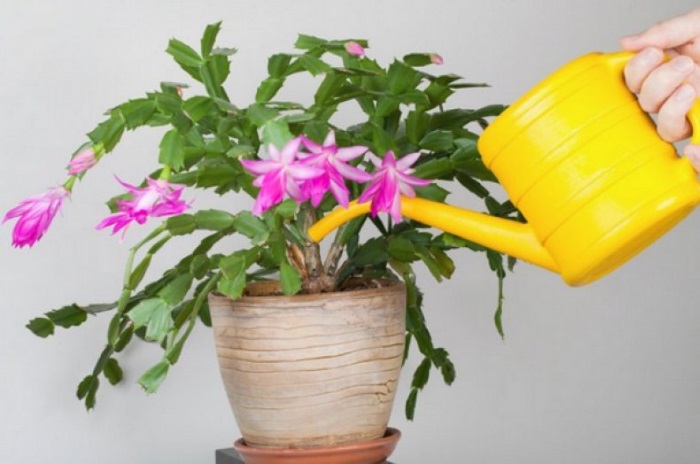
Make sure that no water remains in the support under the pot after watering.
Spacious pot
Since the Decembrist belongs to epiphytes, its root system is poorly developed. This implies that when transplanting, you need to be especially careful when choosing a pot. A deep and wide container is not suitable for him. Ideally, the pot should be wide and shallow, and you can choose the optimal one according to the scheme: the length of the stems should be three times the depth of the pot.

When planted in a deep container, the forces of the flower go to the formation of the root system. In this case, the plant itself develops poorly, and it does not have the strength to form buds and bloom.
Diseases and pests
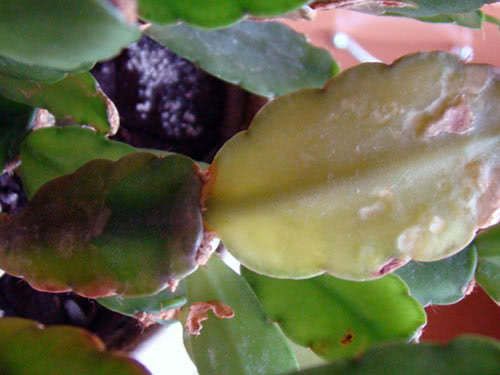
Most often, at home, Schlumberger suffers from attacks of mealybug, scale insects and spider mites.
Due to the defeat of the spider mite, the zygocactus sheds a significant part of the segments and buds.
Also, the plant is susceptible to the development of fungal diseases such as late blight, fusarium, pytium. Most often, they develop in a weakened flower and further aggravate its condition. If you do not notice the symptoms in time or ignore them and do not take measures to treat zygocactus, it may die.
Lack of fertilizers
From March to August, the Christmas tree, as the flower is also called, is actively growing and releasing new foliage. At this time, it is required to carry out weekly fertilizing with suitable fertilizers for cactus. It is better to choose those preparations that are added to the water at the time of watering.
Air humidity
Schlumberger responds well to spraying. In summer, especially at high air temperatures, it is necessary to regularly and abundantly spray the plant with a spray bottle.
Lack of lighting
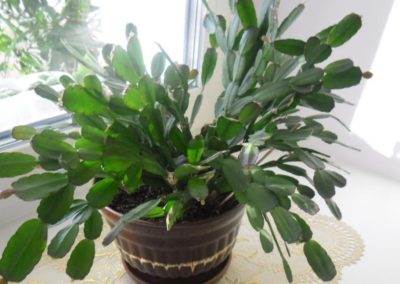
Lack of intense light during the day in September-October negatively affects the flowering of Schlumberger, preventing the plant from setting flower buds.
At the same time, zygocactus does not need a long day of light, it only needs 2 to 4 hours of intense sunlight, best of all during sunset or sunrise, which allows you not to use additional lighting in the cold season.
V autumn-winter period the Decembrist needs 12 hours of complete darkness, this gives the plant the opportunity to rest.
Transfer
The Decembrist does not bloom even in the absence of a transplant for a long time. It has a beneficial effect on the overall development of the plant. This is especially necessary for young flowers, as they grow quickly and constantly need nutrients. A young plant needs to be replanted once a year, and a mature one every 4 years.
During transplantation, you need to completely renew the soil, as it becomes less nutritious, and its structure becomes compacted. Such soil does not only pass water poorly, but also the air necessary for ventilation of the root system. The result is stagnant moisture, root decay and the appearance of diseases. In this state, the Decembrist is unlikely to bloom.
Together with the soil, it is necessary to change the flowerpot and choose its size correctly. It should be 2-3 cm larger than the previous one. The pot should be shallow and wide, since the roots of the plant are located in the upper soil layer. If the container is too large and deep, the flower will spend all its energy on growing roots and filling the pot with them. As a result, there is no longer enough strength for flowering.

